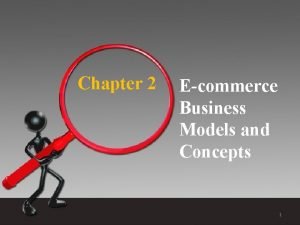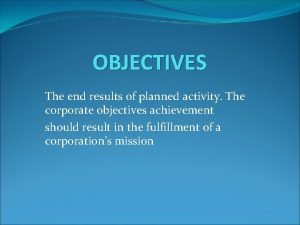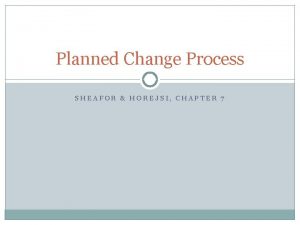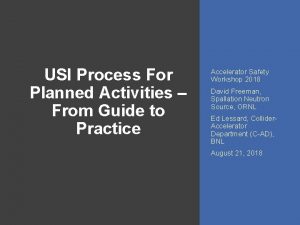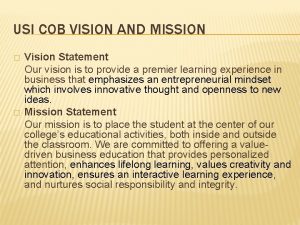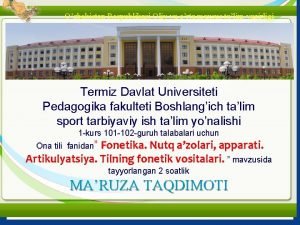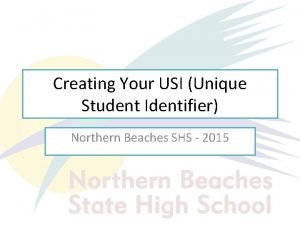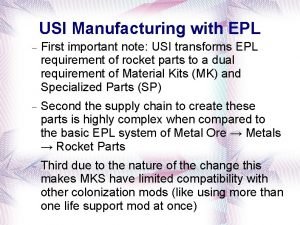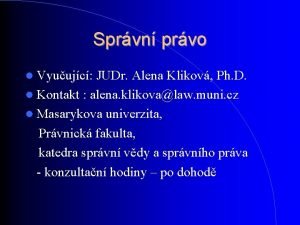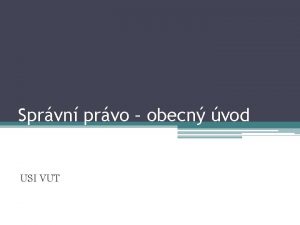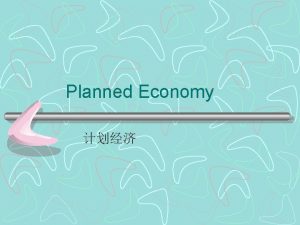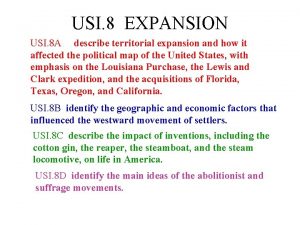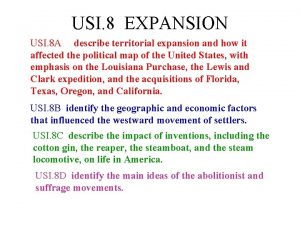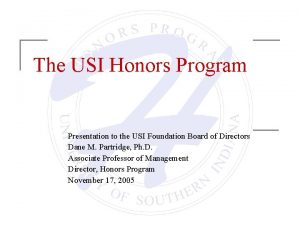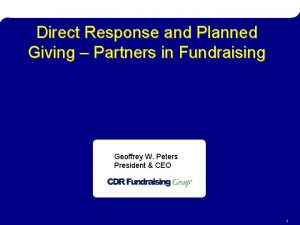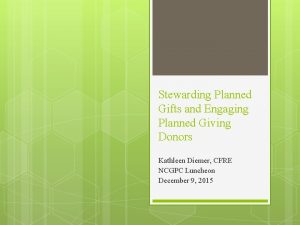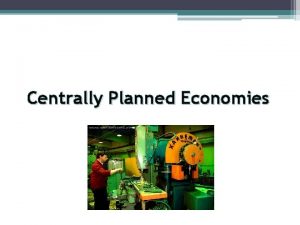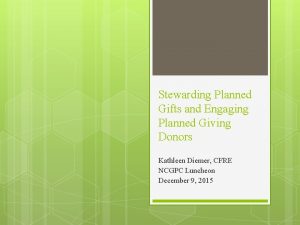USI Process For Planned Activities From Guide to















- Slides: 15

USI Process For Planned Activities – From Guide to Practice Accelerator Safety Workshop 2018 David Freeman, Spallation Neutron Source, ORNL Ed Lessard, Collider. Accelerator Department (C-AD), BNL August 21, 2018

1. Ensures proper hazard analysis performed prior to performing planned activities with potentially significant safety consequences Unreviewed Safety Issue (USI) Process 2. Ensures DOE approval obtained prior to initiating planned activity when required. 3. Serves as important component of configuration management 2

Nuclear Facilities - USQ Process Accelerators - USI Process DOE approves TSRs - Required by 10 CFR 830 DOE approves ASE - Required by 420. 2 C DOE approves safety analysis (DSA) DOE does not approve safety analysis (SAD) DSA revisions submitted to DOE for approval annually SAD revisions are not submitted to DOE for approval USQ process designed to identify DSA changes that warrant pre-approval by DOE USI process not designed to identify SAD changes that warrant DOE pre-approval USQ process is used to maintain DSA USI process is used to maintain SAD current USQ Procedure approved by DOE USI Procedure approved by Contractor “USQ 7 questions” exactly mirror verbiage of 10 CFR 830. 3 “USI 6 questions” = “ 6 of the 7 USQ questions” 3

USI Process Guide Figure Discovered Condition – Not Addressed Today! 4 SNS uses 10 CFR 830 “ 6 questions”; application awkward and confusing, does not fit with Guide

Desire to Improve SNS USI Process • SNS originally adopted “ 6 Question” approach - strong nuclear facility background and influence • Seek process update that: • is compliant with Order, consistent with Guide • dovetails with site-wide configuration management • is clearly understandable by stakeholders (e. g. system engineers, operations, management, etc. ) • Tailor process to audience - develop separate procedures for: • review and approval of proposed changes to CECs • review and approval of new activities An Example: BNL C-AD approach – Implementation of Guide USI Process - no 6 Questions! 5

USI Process Guide Figure Step 1 Step 2 Step 3 6 BNL C-AD Approach: 3 basic steps

What is “Significant Adverse Impact” in the Context of 420. 2 C? • Planned accelerator modifications that have significant adverse impacts are modifications that impact ASE requirements (e. g. , Credited Controls, limits, etc. ) or result in the need to add requirements to the ASE to ensure safety • Examples: 1) New accelerator-enclosure hazard that requires a new credited access control system to ensure safety (e. g. , adding a vacuum cavity pressure interlock system to mitigate ODH) 2) Component replacement that increases the magnitude of machine produced hazard to the extent that a new credited control is needed to ensure safety (e. g. , replacing a klystron with an available but more powerful klystron required a new Credited Control (e. g. , RF power-limiter) to ensure beam-energy stays below limit in ASE) • An example of modification of a limit in the ASE is increasing the accelerators beamenergy limit (e. g. , adding a laser to accelerate electron beam to higher energy) • DOE approval prior to doing the work or operating the accelerator is required for these accelerator modifications • DOE and the contractor set requirements in the ASE and accept the risk 7

Professional Judgement If Yes or Not Sure, then Step 2 Guide USI Process – Step 1: Screening Planned Activities 8

C-AD USI Process Screening Step 1: • Work planning and control process invokes C-AD Questionnaire to identify if potential safety issues could be involved • C-AD Questionnaire – 10 simple questions based on Credited Controls in the ASE • Completed by Group Leaders, Engineers, Operations Coordinators, Supervisors • Identifies work on or changes to CECs • Identifies introduction of any new hazards (rad, ODH) • If “Yes” to any question – process engages USI SME review • USI SME reviews proposed work and may determine: • No potential safety issues, no further analysis warranted; or • Further safety analysis is warranted 9

Guide USI Process – Step 2: Safety Analyses, Contractor Approval of Safety Analysis and Contractor Authorization of Activity 10

USI Determination Form C-AD Form 1. 10. 1 a documents ASE change decision Determinations and Actions Initial or Indicate N/A Determination: The current SAD and/or ASE addresses the hazard associated with the proposed work, event or activity. [ETL] Determination: This activity does not constitute a USI. [ETL] Action: Use this Form, the USI Checklist and attached description, if any, to document the USI Determination until the next revision of the SAD. [ETL] Action: Include this USI Determination as a reference on the ESSHQ Division website “Authorization Bases” after approval by the C-AD Associate Chair for ESSHQ. [ETL] Determination: The hazard associated with the proposed work is not analyzed or is not correctly bounded in the C-AD SAD and/or it is not controlled by an ASE. [N/A] Action: Submit the USI or a revised SAD and/or ASE to the BNL ESH Committee. [N/A] Action: Do not perform activity until BNL has approved. [N/A] Action: Do not perform activity until DOE has approved. [N/A] 11

About 5 to 9 safety analyses changes per year at C-AD without Accelerator Safety Envelope (ASE) change. C-AD has 20 active accelerator facilities; examples: • ERL Organization Changes, June 7, 2017 • UED Magnet Changes, September 27, 2017 • Modification of OPPIS Beam-line to Develop Polarized He-3, October 11, 2017 • BLIP Cask Drop Assessment, November 7, 2017 • LERe. C DC Gun Testing at Low Power, November 8, 2017 • UED Magnet Modifications, December 19, 2017 • SAD Chapter 5 Change to Agree with BLIP ASE Change, January 12, 2018 • ATF Experimental Hall Shield Modification, January 25, 2018 • RHIC Survey-Shaft Shielding Change at 2 O'clock, January 25, 2018 Step 2 - Appended Safety Analyses Keeps the SAD Current 12

Yes Guide USI Process - Step 3: ASE Change/DOE Approval Required 13

About 1 to 3 safety analyses changes per year at C-AD with Accelerator Safety Envelope (ASE) change, examples: • ATF Changes that Correspond to ASE Changes, June 7, 2017 • Klystron Change at ATF (Not Replacement in Kind), January 12, 2018 • RHIC ASE Change to Reflect LERe. C Operations, March 9, 2018 Step 3 - Ensures DOE approval obtained prior to initiating planned activity when required 14

Conclusions/Summary • USI Process ≠ USQ Process • “ 6 Questions” derived directly from 10 CR 830 • Applying “ 6 Questions” to the Accelerators is out of context; not fully understandable or implementable • Process used at C-AD is a safe, responsible and effective process for accelerators • Encourage tailoring of the USI process to meet needs of facility 15
 A wise economist asks a question analysis
A wise economist asks a question analysis A is the set of planned activities designed to result
A is the set of planned activities designed to result In result
In result 7 step planned change process
7 step planned change process Venku se ochladilo a nás zábly uši
Venku se ochladilo a nás zábly uši Ase usi
Ase usi Herbalife mission and vision
Herbalife mission and vision Fonetika slaydlar
Fonetika slaydlar Aiesec lugano
Aiesec lugano Forgot my usi
Forgot my usi Congiuntivo concessivo latino
Congiuntivo concessivo latino Usi contract manufacturing
Usi contract manufacturing Usi manufacturing
Usi manufacturing Vut usi
Vut usi Vut usi
Vut usi Skupina veršov oddelená od inej skupiny medzerou
Skupina veršov oddelená od inej skupiny medzerou

